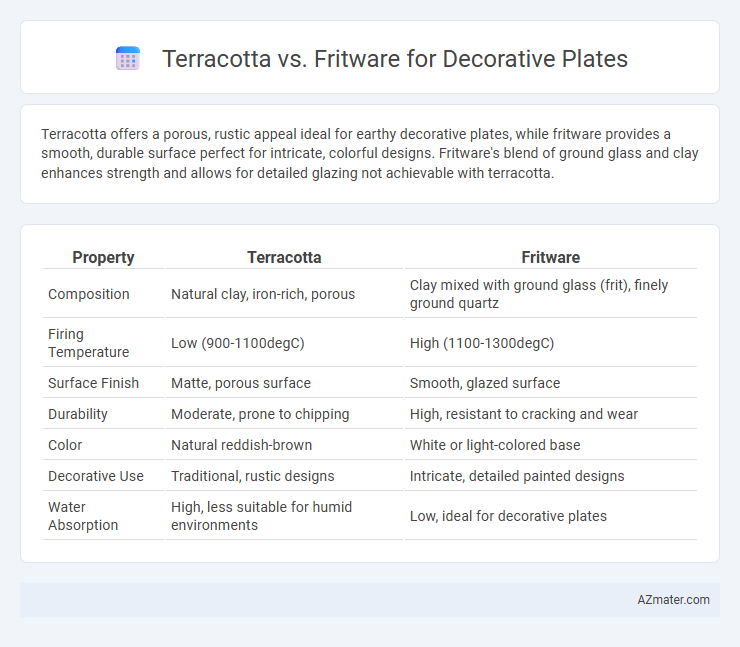Terracotta offers a porous, rustic appeal ideal for earthy decorative plates, while fritware provides a smooth, durable surface perfect for intricate, colorful designs. Fritware's blend of ground glass and clay enhances strength and allows for detailed glazing not achievable with terracotta.
Table of Comparison
| Property | Terracotta | Fritware |
|---|---|---|
| Composition | Natural clay, iron-rich, porous | Clay mixed with ground glass (frit), finely ground quartz |
| Firing Temperature | Low (900-1100degC) | High (1100-1300degC) |
| Surface Finish | Matte, porous surface | Smooth, glazed surface |
| Durability | Moderate, prone to chipping | High, resistant to cracking and wear |
| Color | Natural reddish-brown | White or light-colored base |
| Decorative Use | Traditional, rustic designs | Intricate, detailed painted designs |
| Water Absorption | High, less suitable for humid environments | Low, ideal for decorative plates |
Introduction to Decorative Ceramics
Decorative ceramics often utilize terracotta and fritware, two distinct materials with unique properties influencing their aesthetic and durability. Terracotta, a porous clay fired at lower temperatures, offers a warm, earthy tone ideal for rustic, traditional designs, while fritware, composed of a glass-like substance fused with clay and fired at higher temperatures, provides a smooth, white surface perfect for intricate, colorful glazing. Understanding these differences helps collectors and artisans choose the right ceramic type for desired decorative effects and functional longevity.
What is Terracotta?
Terracotta is a type of earthenware made from natural clay fired at low temperatures, resulting in a porous, reddish-brown material ideal for decorative plates due to its rustic and warm aesthetic. Its unglazed surface allows for intricate hand-painted designs, while its durability makes it suitable for both indoor and outdoor use. Unlike fritware, terracotta's organic composition and traditional firing process highlight a natural texture and earthy appeal favored in artisanal ceramics.
What is Fritware?
Fritware is a type of ceramic material composed of ground glass (frit), clay, and quartz, which creates a dense, white body ideal for intricate decorative plates. Unlike terracotta, fritware offers a smoother, less porous surface that allows for finer, more detailed painting and glazing. Its unique composition enhances durability and aesthetic appeal, making fritware a preferred choice for high-quality decorative ceramics.
Historical Origins and Evolution
Terracotta, originating from ancient civilizations such as Mesopotamia and the Indus Valley, is a clay-based ceramic known for its porous texture and warm, earthy tones, commonly used in traditional pottery and decorative plates. Fritware, developed during the Islamic Golden Age around the 9th century in Persia, incorporates a glass frit additive to create a white, smooth surface ideal for intricate painted designs and vibrant glazes, representing a technological evolution in ceramic artistry. The transition from terracotta to fritware marked a significant enhancement in both aesthetic possibilities and material durability, reflecting advances in kiln technology and artistic expression throughout history.
Material Composition and Properties
Terracotta is a porous clay-based ceramic composed primarily of iron-rich clay, fired at lower temperatures around 1000degC, resulting in a durable yet more brittle material with a rustic, earthy appearance suited for traditional decorative plates. Fritware, also known as stonepaste, combines finely ground quartz or glass frit with white clay and is fired at higher temperatures near 1200degC, producing a denser, less porous surface that allows for intricate painted designs and a smoother, more refined finish. The key differences lie in terracotta's porous, absorbent nature versus fritware's compact, vitrified texture, making fritware preferable for detailed artistry and longer-lasting decorative plates.
Crafting Techniques: Terracotta vs Fritware
Terracotta crafting involves shaping natural clay followed by low-temperature firing, which results in a porous and rustic texture ideal for earthy decorative plates. Fritware, on the other hand, combines ground quartz with clay and glass frit before firing at higher temperatures, producing a denser and smoother surface suited for intricate glazing and detailed designs. The distinct heating and material processes in Terracotta and Fritware directly influence the durability and aesthetic finish of decorative plates.
Aesthetic Differences and Design Preferences
Terracotta decorative plates feature a warm, earthy tone with a porous texture that enhances rustic and traditional aesthetics, often showcasing hand-painted motifs with natural pigments. Fritware plates, crafted from a glassy, fine white body, offer a smooth surface ideal for intricate, colorful designs and detailed glazing, suiting more refined and ornamental preferences. The choice between terracotta and fritware reflects variations in design priorities, with terracotta emphasizing organic charm and fritware highlighting elegance and precision in decorative art.
Durability and Functionality Comparison
Terracotta decorative plates, made from porous clay, are more prone to chipping and moisture absorption, reducing their long-term durability compared to fritware, which incorporates ground glass to create a denser, less porous material. Fritware's enhanced structural integrity offers superior resistance to cracking and staining, making it more suitable for functional use and regular handling. While terracotta is favored for its earthy texture and traditional appeal, fritware provides a more durable and practical option for decorative plates exposed to frequent use or environmental stress.
Popular Uses in Decorative Plates
Terracotta is favored for decorative plates due to its warm, earthy tones and porous texture, making it ideal for rustic and traditional designs. Fritware, composed of finely ground silica and glass frit, offers a smooth, white surface perfect for intricate patterns and vibrant glazes often seen in Middle Eastern and Islamic art. Both materials enhance aesthetic appeal, with terracotta emphasizing natural charm and fritware providing durability and detailed artistry in decorative plates.
Choosing the Right Material for Decorative Plates
Terracotta offers a porous, reddish clay foundation ideal for rustic, earthy decorative plates, prized for its natural texture and affordability but requires sealing to prevent moisture absorption. Fritware combines finely ground quartz and glass with clay, producing a dense, white, and smooth surface perfect for intricate painted designs and durable finishes. Selecting between terracotta and fritware depends on desired aesthetics, durability needs, and whether a matte or glossy finish complements the decorative style.

Infographic: Terracotta vs Fritware for Decorative Plate
 azmater.com
azmater.com